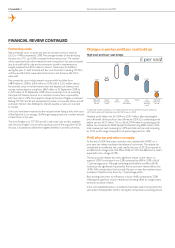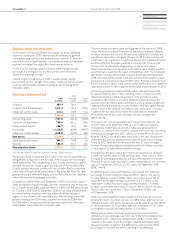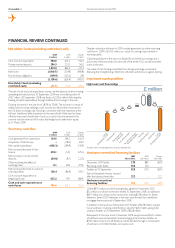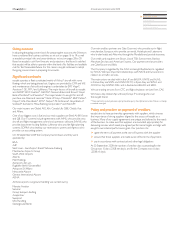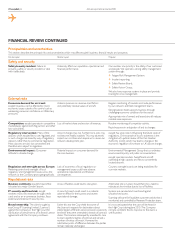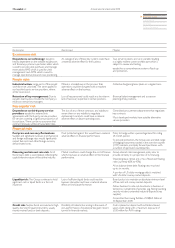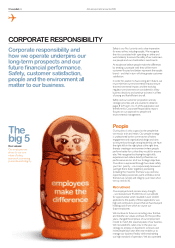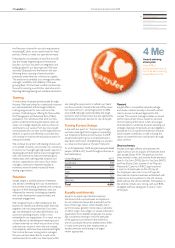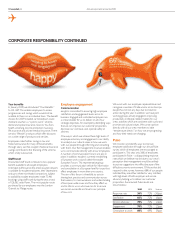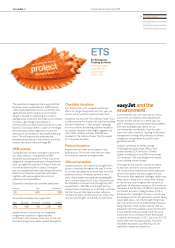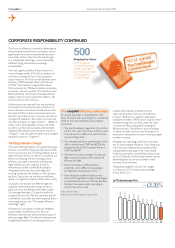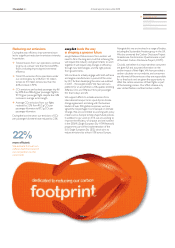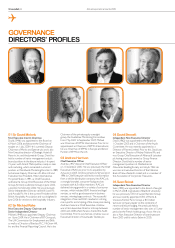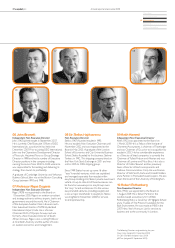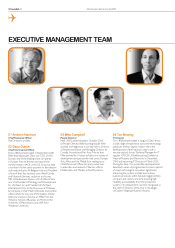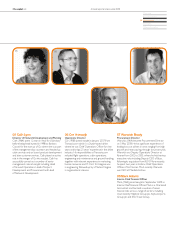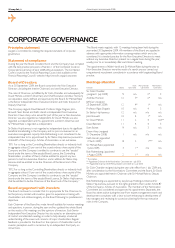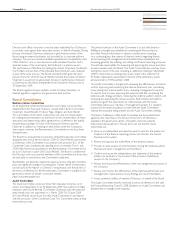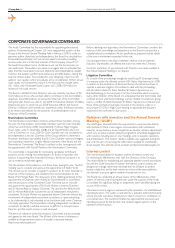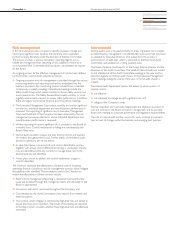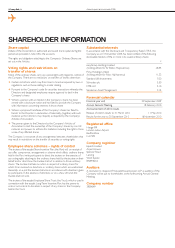EasyJet 2009 Annual Report Download - page 36
Download and view the complete annual report
Please find page 36 of the 2009 EasyJet annual report below. You can navigate through the pages in the report by either clicking on the pages listed below, or by using the keyword search tool below to find specific information within the annual report.
34 easyJet plc Annual report and accounts 2009
q
CORPORATE RESPONSIBILITY CONTINUED
Our focus on efciency is central to delivering our
environmental commitments, and means we are
signicantly more environmentally efcient than
most other airlines. Over time this will also give
us a competitive advantage, as environmentally
inefcient ying will become increasingly
unsustainable.
The most signicant effect of the emissions of
mono-nitrogen oxides (NOx) from aviation are
currently considered to be on local air quality
around airports. All of our aircraft deliveries since
February 2008 have been tted with the new
CFM56 “Tech Insertion” engines that reduce
NOx emissions by 25% due to better combustion
processes – almost a quarter of our eet are now
tted with these more environmentally efcient
engines which are also expected to deliver a 1%
improvement in CO2 emissions.
At the airports we operate from, we also have a
local impact on the environment in the form of
noise. However, our business model ensures that
the impact of this on the local environment is less
than for many other carriers. Our new aircraft are
amongst the quietest in the industry and we have
very few operations at night (2300 hrs – 0600 hrs)
when noise is of the greatest concern. All of the
aircraft in our eet are compliant with the latest
required international noise standards, known as
“Chapter 3”, but also with the latest more stringent
standard, known as “Chapter 4”.
Tackling climate change
The overwhelming majority of our greenhouse gas
emissions come from ying (we estimate less than
1% of our emissions are non-ying related), and it is
these emissions which we report on and focus our
efforts on reducing. We are working to be as
efcient as possible, in particular by ying new,
highly efcient aircraft, using our aircraft as
efciently as possible, continually focusing on
reducing the emissions from each ight and
working to improve the efciency of the airspace
we y in. Due to this, we are the most efcient
airline on a signicant majority of the routes we y.
Our policy is to expand our eet through the
acquisition of the latest technology aircraft, as
these are more fuel efcient than older models.
Our average eet age is 3.5 years, broadly at
compared to last year. We also use these aircraft
as efciently as possible, by maximising load factors
and seating density (see “The easyJet efciency
advantage”, right).
All aspects of our business model are designed
around safety and efciency. This focus on
efciency minimises the environmental impact of
each passenger ight. Our network development
has generally focused on substituting services in
markets dominated by inefcient former
state-owned airlines with our more efcient
product – 80% of our capacity is deployed in
established markets. While we aim to grow these
markets through our low fares, when we enter
a market we often substitute for existing less
efcient services. The efciency that we bring to
a market can even result an overall reduction in
emissions in absolute terms, even if total passenger
numbers increase.
Alongside our operating model we work every
day on improving the efciency of our ying, and
in the last year implemented a number of fuel
saving initiatives (see page 15 for more detail).
Finally, by pushing for more efcient airspace use,
such as Continuous Decent Approaches, we are
demanding that our service providers match
our level of commitment.
Taking these together we have set a target
to reduce our CO2 emissions per passenger
Km by 3% by 2011.
The easyJet efficiency advantage
An easyJet passenger is responsible for 22%
fewer emissions than a passenger on a traditional
airline to the same destination and using the
same plane
The typical seating conguration of an Airbus
q
A319 is 1241 seats. Our Airbus A319s y with
156 seats which is 26% more seats than the
normal conguration
Our average load factor (percentage of seats
q
sold) in nancial year 2009 was 85.5%; the
average load factor for European airlines in
2009 was 68.0%2
Therefore, we sell on average 133 seats per
q
ight; a typical European airline would sell
84 seats per ight
Each of our Airbus A319s therefore
q
potentially carries 58% more passengers
per ight than the European norm
Even taking the additional fuel burn into
q
account for the greater number of passengers,
we estimate that we burn 22% less fuel than
the typical European airline operating an
A319 on the same route
Note 1: Source: Airbus.
Note 2: Source: AEA for January–August 2009.
500
Shaping the future:
Over 500 global
companies, including
easyJet, have signed
up to the Copenhagen
Communiqué on
Climate Change.
– (3.3)%
g CO2/passenger Km
116.20
112.50
106.90
110.00
104.50
98.80
95.70
95.56
90.31
87.30
00 01 02 03 04 05 06 07 08 09


